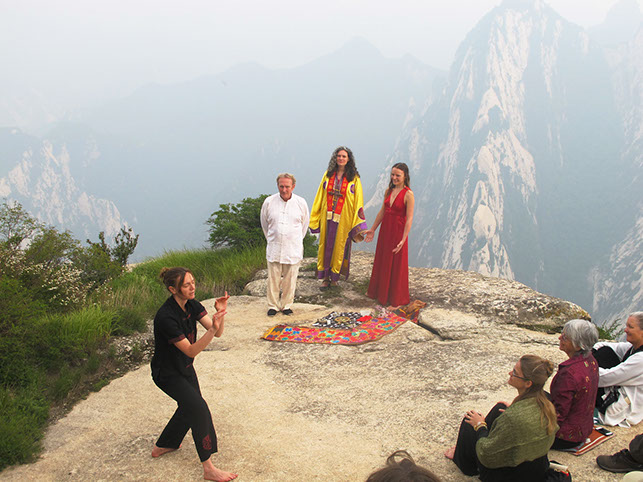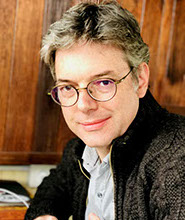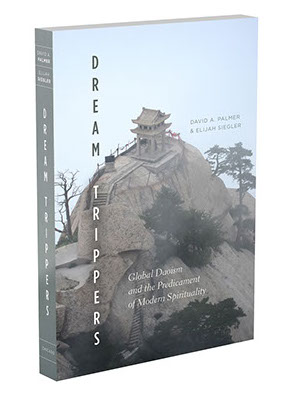_01.png?crc=4174553115)
Cover Story
Research
People
Books
Archive
Download PDF
Download PDF
E-book version
Teaching
and Learning
Knowledge
Exchange
In 2004, Healing Tao USA, one of the main promoters of Daoism in that country, organised a ‘China Dream Trip’ to sacred Daoist sites as well as the Great Wall and other attractions. They were accompanied by Dr David Palmer of the Department of Sociology and Professor Elijah Siegler of the College of Charleston, who wanted to study what happened when these spiritual tourists came face to face with traditional Daoism. What they discovered was a story of unrepentant cultural appropriation, disillusion, and the search for spirituality in the modern world.
The story, described in the recently-published Dream Trippers: Global Daoism and the Predicament of Modern Spirituality, focusses on Huashan, a sacred Daoist mountain with monasteries and hermits living in caves. The scholars joined several Healing Tao tours to the region and separately interviewed the monks and hermits. From the start, they found the two cultures were at odds. “The Dream Trippers and the monks for the most part have quite different ideas about the meaning of the Dao and how to access it,” Dr Palmer said.
The Americans hoped to absorb the energies of Dao through qigong and other practices based on what he calls ontological individualism, “the idea being that you yourself are the ultimate authority and so spiritual practices are really about knowing yourself.” The monks, on the other hand, believe the authentic Dao is not about knowing the self, but about practising ritual, cultivating a master-disciple relationship and respecting a formal lineage in order to achieve ‘cosmological attunement’.
Adding further complexity to the story is the presence of a leading American scholar and practitioner of Daoism, Professor Louis Komjathy, who happened to be in the same town as the Dream Trippers after one of the Huashan visits. A purist, he was on a quest to find an authentic Daoist tradition in China and wanted nothing to do with the consumerist Dao of his compatriots. He followed Dr Palmer’s casual suggestion to visit Huashan and ended up becoming a disciple of one of the leading monks, Master Chen. “Komjathy and the leader of Healing Tao, Michael Winn, are engaged in a polemic against each other in the book on what is the true Dao and how to promote Daoism in the US,” Dr Palmer said. “Meanwhile, even as he remained critical of both approaches, Chen was both a consultant for Winn’s tours and the lineage master in Komjathy’s spiritual apprenticeship.”
Chen related the tensions between the different views on Daoism to a container of water: Komjathy paid too much attention to the container – the practices, organisation and lineage – while Winn wanted to bring the water, the Dao, to America without a container.
Invented liturgy
These approaches would ultimately prove fateful for the two players. Chen’s monastery was highly politicised, due to both external forces and internal in-fighting. Chen decided to quit and live a low-key life as an urban hermit, while Komjathy became disillusioned by the state of Daoism in China and returned to the US. “While he deeply appreciates that tradition still exists in China, by the end of the summer of 2011 he felt there was not much more he could learn there,” Dr Palmer said.
Winn displayed growing appreciation of the Daoist tradition as understood in China, but at the same time was unapologetic about his approach. In 2012 he organised a Daoist wedding at a secluded spot atop Huashan, even though this ritual does not exist in Daoist tradition. Dr Palmer was a witness.
“They had a completely invented liturgy with invented Daoist rituals that talked about the sexual coupling of the yin and yang energies of the bride and groom uniting on this sacred mountain,” he said. The final scene in the book is of the wedding guests joining in a group hug, chanting ‘Ohm’.
Dr Palmer shared the manuscript with the main protagonists and their responses were telling. Winn provided 60 pages of comments with academic references. Komjathy, who had been most critical of the project, made some factual corrections. Chen, when asked if there were any factual errors about him he would like corrected, replied cryptically that if the book gave a bad impression of him, he deserved it.
Dr Palmer said the fragmentation around questions of authenticity and authority that he and Siegler observed is not confined to Daoism – Christianity, for instance, is also deeply splintered as more people resist having an authority or institution mediate their religious experiences.
“Christianity has a lot of negative baggage for Westerners, which is why some are interested in Daoism, which they see as a pure spirituality. For many Chinese it is the opposite – they see Daoism as representing the backwards and dark aspects of Chinese history and culture and Christianity as something new and fresh,” he said. “These are the predicaments of modern spirituality.”
Dream Trippers: Global Daoism and the Predicament of Modern Spirituality is published by the University of Chicago Press.
Next
Master Chen, a Daoist monk of the Order of Complete Perfection.
(Courtesy of Michael Winn)

A Spiritual Clash Of Cultures
What happens when Western Daoists go on a pilgrimage to find the ‘real Dao’ in China? A new book follows these pilgrims, tracing the impact on the participants and the monks they visit and offering insights on the state of modern spirituality.
![]() Christianity has a lot of negative baggage
Christianity has a lot of negative baggage
for Westerners, which is why some are interested in Daoism, which they see as a
pure spirituality. For many Chinese it is the opposite. ![]()
Dr David Palmer


.jpg?crc=99933374)
Qigong dance during a Daoist wedding ceremony atop Huashan, China.
_12.png?crc=11173089)